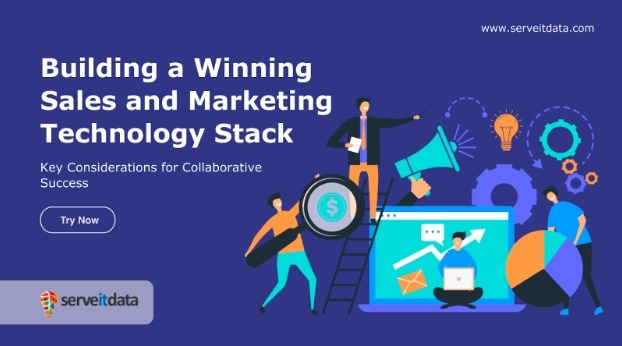Building a Winning Sales and Marketing Technology Stack: Key Considerations for Collaborative Success
In today’s digital age, sales and marketing teams rely heavily on technology to streamline processes, improve efficiency, and drive revenue growth. However, with the vast array of sales and marketing tools available, it can be challenging to build a cohesive and effective technology stack that aligns the efforts of both teams. In this blog post, we will explore the key considerations for building a winning sales and marketing technology stack that fosters collaboration and drives success.

Define Your Goals and Requirements:
Before selecting any tools or technologies, it’s crucial to define your goals and identify the specific requirements of your sales and marketing teams. Assess your existing processes and workflows to identify pain points, bottlenecks, and areas for improvement. Determine the key objectives you want to achieve with your technology stack, whether it’s improving lead generation, increasing conversion rates, enhancing customer engagement, or optimizing sales and marketing alignment.
Collaborative Evaluation and Selection:
To build a technology stack that fosters collaboration, it’s important to involve both sales and marketing teams in the evaluation and selection process. Gather input from both teams to understand their unique needs, challenges, and preferences. Consider holding collaborative workshops or meetings to discuss the functionalities, features, and integrations required by each team. This collaborative evaluation ensures that the chosen tools address the specific needs of both sales and marketing.
Integration and Data Flow:
One of the critical considerations when building a sales and marketing technology stack is ensuring seamless integration and data flow between the different tools and systems. Look for tools that offer native integrations or robust APIs to connect various platforms. Smooth data flow between your customer relationship management (CRM) system, marketing automation platform, email marketing software, analytics tools, and other essential systems is essential for a unified view of the customer journey and effective collaboration between teams.
Scalability and Flexibility:
As your business grows, your sales and marketing needs may evolve, requiring scalability and flexibility in your technology stack. Consider the scalability of the tools you choose and their ability to accommodate the growing demands of your business. Additionally, ensure that the tools offer flexibility and customization options to adapt to your unique sales and marketing processes and workflows.
Training and Adoption:
Implementing new technology within your organization requires proper training and adoption strategies to ensure that your sales and marketing teams can fully leverage the capabilities of the tools. Provide comprehensive training sessions and resources to familiarize your teams with the functionalities and best practices of the tools. Encourage ongoing learning and create a culture of continuous improvement to maximize the value derived from your technology stack.
Data Security and Compliance:
When selecting sales and marketing tools, prioritize data security and compliance. Ensure that the tools you choose adhere to industry-standard security measures and comply with relevant data protection regulations, such as the General Data Protection Regulation (GDPR) or the California Consumer Privacy Act (CCPA). Protecting customer data is paramount, and utilizing tools that prioritize data security builds trust with your customers and reduces the risk of data breaches.
Analytics and Reporting:
Effective sales and marketing strategies require data-driven insights. Consider the analytics and reporting capabilities of the tools in your technology stack. Look for tools that provide robust reporting dashboards, customizable analytics, and the ability to track key performance indicators (KPIs) relevant to both sales and marketing teams. Accessible and actionable data allows teams to make informed decisions, optimize strategies, and drive collaborative success.
Continuous Evaluation and Optimization:
Building a winning sales and marketing technology stack is not a one-time endeavor. It requires continuous evaluation, optimization, and adaptation to meet the evolving needs of your business and industry. Regularly assess the performance and impact of the tools in your stack and solicit feedback from your sales and marketing teams. Identify areas for improvement and explore emerging technologies or trends that can enhance collaboration and drive better results.
In conclusion, building a winning sales and marketing technology stack requires careful evaluation, collaboration, and consideration of various factors. By defining your goals and requirements, involving both teams in the evaluation and selection process, prioritizing integration and data flow, ensuring scalability and flexibility, focusing on training and adoption, prioritizing data security and compliance, emphasizing analytics and reporting, and committing to continuous evaluation and optimization, you can create a technology stack that fosters collaborative success and drives your sales and marketing efforts to new heights.


